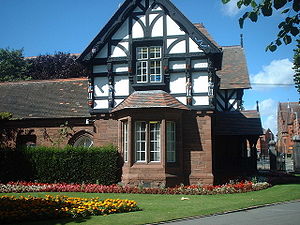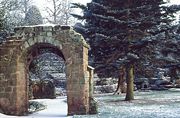
Grosvenor Park, Chester
Encyclopedia

Chester
Chester is a city in Cheshire, England. Lying on the River Dee, close to the border with Wales, it is home to 77,040 inhabitants, and is the largest and most populous settlement of the wider unitary authority area of Cheshire West and Chester, which had a population of 328,100 according to the...
, Cheshire
Cheshire
Cheshire is a ceremonial county in North West England. Cheshire's county town is the city of Chester, although its largest town is Warrington. Other major towns include Widnes, Congleton, Crewe, Ellesmere Port, Runcorn, Macclesfield, Winsford, Northwich, and Wilmslow...
, England . It consists of 20 acres (8.1 ha) of land overlooking the River Dee
River Dee, Wales
The River Dee is a long river in the United Kingdom. It travels through Wales and England and also forms part of the border between the two countries....
. It is regarded as one of the finest and most complete examples of Victorian
Victorian era
The Victorian era of British history was the period of Queen Victoria's reign from 20 June 1837 until her death on 22 January 1901. It was a long period of peace, prosperity, refined sensibilities and national self-confidence...
parks in the North West of England, if not nationally. The park is designated as Grade II in the National Register of Historic Parks and Gardens
National Register of Historic Parks and Gardens
In England, the Register of Historic Parks and Gardens of special historic interest in England provides a listing and classification system for historic parks and gardens similar to that used for listed buildings. The register is managed by English Heritage under the provisions of the National...
.
History
The land, which formerly consisted of fields, was given to the city by Richard Grosvenor, 2nd Marquess of WestminsterRichard Grosvenor, 2nd Marquess of Westminster
Richard Grosvenor, 2nd Marquess of Westminster KG, PC , styled Viscount Belgrave from 1802 to 1831 and Earl Belgrave from 1831 to 1845, was an English politician, landowner, property developer and benefactor....
. The Marquess also paid for the design of the park by Edward Kemp
Edward Kemp
Edward Kemp was an English landscape architect and an author. Together with Joseph Paxton and Edward Milner, Kemp became one of the leaders in the design of parks and gardens during the mid-Victorian era in England....
. It was laid out in 1865–66 and opened with great celebration in November 1867 although the Marquess was not able to attend.
Grosvenor Park Lodge
This was originally the park keeper's lodge and is now the city council's parks & gardens office. It was designed by local architect John DouglasJohn Douglas (architect)
John Douglas was an English architect who designed about 500 buildings in Cheshire, North Wales, and northwest England, in particular in the estate of Eaton Hall. He was trained in Lancaster and practised throughout his career from an office in Chester, Cheshire...
. The lodge, together with some of the other structures in the park, are among his first recorded commissions by the Grosvenor family, and the first known example of his use of black-and-white architecture. The lodge is in two storeys, the lower storey being built in red sandstone
Sandstone
Sandstone is a sedimentary rock composed mainly of sand-sized minerals or rock grains.Most sandstone is composed of quartz and/or feldspar because these are the most common minerals in the Earth's crust. Like sand, sandstone may be any colour, but the most common colours are tan, brown, yellow,...
and the upper storey being timber-framed
Timber framing
Timber framing , or half-timbering, also called in North America "post-and-beam" construction, is the method of creating structures using heavy squared off and carefully fitted and joined timbers with joints secured by large wooden pegs . It is commonplace in large barns...
with plaster panels. The roofs are of red-brown tiles. On the upper storey are eight carvings which represent William the Conqueror
William I of England
William I , also known as William the Conqueror , was the first Norman King of England from Christmas 1066 until his death. He was also Duke of Normandy from 3 July 1035 until his death, under the name William II...
and the seven Norman
Norman dynasty
Norman dynasty is the usual designation for the family that were the Dukes of Normandy and the English monarchs which immediately followed the Norman conquest and lasted until the Plantagenet dynasty came to power in 1154. It included Rollo and his descendants, and from William the Conqueror and...
Earls of Chester
Earl of Chester
The Earldom of Chester was one of the most powerful earldoms in medieval England. Since 1301 the title has generally been granted to heirs-apparent to the English throne, and from the late 14th century it has been given only in conjunction with that of Prince of Wales.- Honour of Chester :The...
. The lodge has been designated by English Heritage
English Heritage
English Heritage . is an executive non-departmental public body of the British Government sponsored by the Department for Culture, Media and Sport...
as a Grade II listed building.
Contents

Billy Hobby's Well
Billy Hobby's Well is in Grosvenor Park, Chester, Cheshire, England. Its canopy has been designated by English Heritage as a Grade II listed building.-History:...
, which was reputed to have magical properties. John Douglas designed a canopy
Canopy (building)
A canopy is an overhead roof or else a structure over which a fabric or metal covering is attached, able to provide shade or shelter. A canopy can also be a tent, generally without a floor....
to stand over the site of the well. The canopy is listed Grade II. Money was raised by public subscription to erect a statue to the 2nd Marquess in 1859. The statue is in white marble
Marble
Marble is a metamorphic rock composed of recrystallized carbonate minerals, most commonly calcite or dolomite.Geologists use the term "marble" to refer to metamorphosed limestone; however stonemasons use the term more broadly to encompass unmetamorphosed limestone.Marble is commonly used for...
and was made by Thomas Thornycroft
Thomas Thornycroft
Thomas Thornycroft was an English sculptor and engineer.-Biography:Thomas Thornycroft was born near Gawsworth, Cheshire, the eldest son of John Thornycroft, a farmer. He was educated at Congleton Grammar School and then briefly apprenticed to a surgeon. He moved to London where he spent four...
. The statue was originally surrounded by four guns, two being Boer
Boer
Boer is the Dutch and Afrikaans word for farmer, which came to denote the descendants of the Dutch-speaking settlers of the eastern Cape frontier in Southern Africa during the 18th century, as well as those who left the Cape Colony during the 19th century to settle in the Orange Free State,...
guns which were captured in the Boer War
Second Boer War
The Second Boer War was fought from 11 October 1899 until 31 May 1902 between the British Empire and the Afrikaans-speaking Dutch settlers of two independent Boer republics, the South African Republic and the Orange Free State...
and the other two were Russia
Russia
Russia or , officially known as both Russia and the Russian Federation , is a country in northern Eurasia. It is a federal semi-presidential republic, comprising 83 federal subjects...
n guns which had been captured at Sebastopol
Sevastopol
Sevastopol is a city on rights of administrative division of Ukraine, located on the Black Sea coast of the Crimea peninsula. It has a population of 342,451 . Sevastopol is the second largest port in Ukraine, after the Port of Odessa....
in the Crimean War
Crimean War
The Crimean War was a conflict fought between the Russian Empire and an alliance of the French Empire, the British Empire, the Ottoman Empire, and the Kingdom of Sardinia. The war was part of a long-running contest between the major European powers for influence over territories of the declining...
. The guns are no longer present. The statue is listed Grade II.
In the park are three medieval
Middle Ages
The Middle Ages is a periodization of European history from the 5th century to the 15th century. The Middle Ages follows the fall of the Western Roman Empire in 476 and precedes the Early Modern Era. It is the middle period of a three-period division of Western history: Classic, Medieval and Modern...
arches moved from elsewhere in the city, both of which are listed Grade II. St Mary's Arch with its wing walls dates from around the 13th century and formerly stood in St Mary's Benedictine Nunnery. The Old Shipgate Arch
Shipgate
The Shipgate is a sandstone arch standing in Grosvenor Park, Chester, Cheshire, England.-History:The archway originally provided an entrance to the city from the area of the docks on the banks of the River Dee. It stood in the southern section of the walls to the west of Bridgegate...
formerly stood to the west of the Bridgegate
Bridgegate, Chester
The Bridgegate is in Chester, Cheshire, England. It forms part of the city walls and has been designated by English Heritage as a Grade I listed building.-History:...
and was taken down in 1831. The third archway was removed from St Michael's Church
St Michael's Church, Chester
St Michael's Church, Chester is a redundant church standing on the corner of Bridge Street and Pepper Street in the city of Chester, Cheshire, England. It has been designated by English Heritage as a Grade II listed building. The former church is now used as a heritage centre.-History:A...
. Also in the park and listed Grade II is Jacob's Well Drinking Fountain consisting of a small stone arch with a drinking fountain for people and a dish for their pets, which is now dry. During the laying out of the park a long line of Roman earthenware water pipes was discovered close to the lodge which used to bring fresh water from Boughton
Boughton, Cheshire
Boughton is a neighbourhood to the east of Chester city centre, part of the unitary authority of Cheshire West and Chester and the ceremonial county of Cheshire, England...
to the Roman fortress. In the 1950s a rockery was constructed on the southern edge of the park with waterfalls, streams and fountains. The main gates of the park, together with other gate piers and sections of the park walls, all designed by John Douglas, are listed Grade II.
Activities
A number of cultural and horticultural events, including events in the Summer Music Festival, are held in the park. Also in the park is the Grosvenor Park Miniature Railway which was built in 1996 to commemorate the centenary of the Duke of WestminsterDuke of Westminster
The title Duke of Westminster was created by Queen Victoria in 1874 and bestowed upon Hugh Grosvenor, 3rd Marquess of Westminster. The current holder of the title is Gerald Grosvenor, 6th Duke of Westminster....
's railway at Eaton Hall
Eaton Hall (Cheshire)
Eaton Hall is the country house of the Duke of Westminster. It is set within a large estate south of the village of Eccleston, in Cheshire, England . The house is surrounded by formal gardens, parkland, farmland and woodland. The estate covers an area of about .The first substantial house was...
. It has a gauge of 7.25 inches (18 cm) and a circuit of 0.25 mile (0.402335 km).

